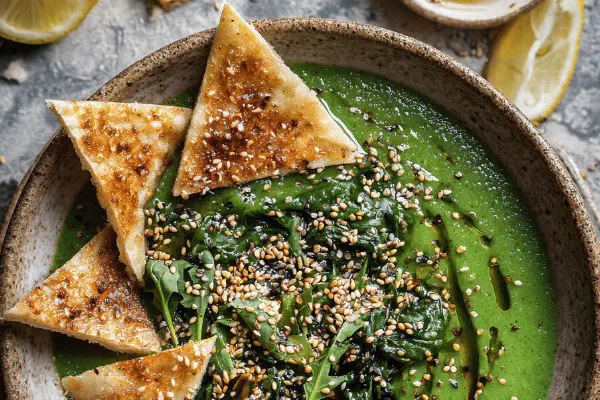Featured Recipe
Roasted Spiced Squash Soup

By Kate
"
A hearty soup using roasted delicata squash and sweet potatoes, combined with sautéed shallots and ginger. Simmered in vegetable stock, pureed smooth, then finished with toasted pepitas and a drizzle of chili oil for a subtle kick. Gluten-, nut-, dairy-, egg-free. Relies on visual cues like golden skin and soft flesh to judge roasting and simmering rather than strict timings.
"
Prep:
25 min
Cook:
35 min
Total:
60 min
Serves:
6 servings
soup
vegan
healthy
fall recipes
Introduction
Starting with roasting — crucial to get those caramelized notes out of the squash and sweet potato. Don’t rush this. The color on the edges? That’s where flavor lives. Getting that browned crust means sugars breaking down, complexity. Meanwhile the shallots and ginger build your aromatic base, sweat them low and slow in coconut oil — burns ruin flavor. Simmer just enough to marry everything but not drown the fresh taste of the veggies. Puree until velvet smooth or leave a bit chunky if you want rustic texture. Toasted pepitas add crunch and chili oil? Small hit, big punch. Simple swaps there, flexibility key if allergy or pantry limited. Visual cues, texture, aromas — trust your senses over timers every step. Kitchen reality beats rigid clock.
Ingredients
About the ingredients
Delicata squash chosen for thin skin — no peeling needed, saves time and preserves nutrients. Sweet potato adds creamy body; peeled to avoid stringiness. Smoked paprika gives subtle warmth without overpowering. Coconut oil ideal for its high smoke point and slight sweetness but substitutable with unsalted butter or olive oil for different flavor profiles. Shallots provide mild sweetness and complexity over regular onions. Fresh ginger lends brightness and bite to balance roasted earthiness. Pepitas toasted until popping lightly to bring crunch and nutty aroma. Chili oil - optional but brings subtle heat; can swap for cayenne or omit if heat sensitive. Stock should be quality vegetable stock to keep soup light; chicken works if no diet restrictions. Salt and pepper must be adjusted at end — both bring out flavors and balance sweetness from roasting.
Method
Technique Tips
Roasting at high heat allows Maillard reaction to develop rich flavor on the vegetables — crucial to skip boiling raw squash or you lose that layer of complexity. Watch visual cues — a deep amber color and slight crisp on edges signals readiness. Turning veggies during roasting avoids scorching. When sweating shallots and ginger, cook low till translucent and fragrant — avoid browning to keep sweetness intact. Simmering after roasting allows flavors to marry, thickness to develop but don’t overdo, or starchiness from the sweet potato gets overwhelming. Puree hot but carefully — hot liquids in blender can splash; best to blend in batches or use immersion blender with caution. Adjust thickness with stock to preference after blending. Season last — salt draws out sweetness and balances bitterness, pepper adds subtle bite. Garnishes aren’t just decorative — pepitas add needed texture contrast while chili oil introduces targeted heat to brighten bowl. A flexible approach to modern allergy considerations, sub ingredients thoughtfully, and always check doneness visually and by feel.
Chef's Notes
- 💡 Watch the squash. Deep amber edges signal readiness for roasting. Texture? Should pierce easily. Sweet potato adds creaminess. Peeling prevents stringiness.
- 💡 Stir gently while sweating shallots and ginger. Cook low and slow. Soft but no browning. Too much heat ruins the gentle aroma. That’s sweetness.
- 💡 Simmer only until married. Look for gentle bubbling. Overdoing it thickens too much from sweet potatoes. Taste often, adjust seasoning last.
- 💡 Blend carefully; hot liquids can splash. Work in batches if using blender. Or just use immersion blender right in pot. Keep tactile feel.
- 💡 Pepitas need to toast lightly; the popping sound is key. Adds crunch. If heat's too much, skip the chili oil. Sub cayenne or omit.
Kitchen Wisdom
How to know squash is done roasting?
Dark edges are good. Look for softness. Not mushy. A bit of crisp on outside is ideal.
Can I use other vegetables?
Yes, alternate squash types, root veggies. Carrots, parsnips offer varied flavors. Experiment but watch roasting.
What if soup is too thick?
Add more stock gradually. Blend again if necessary. Work to desired consistency. Avoid watery. Balance texture.
Storage options?
Keeps well in fridge for 3-4 days. Cool before storing. Freezing is also viable, but may alter texture. Reheat gently.



